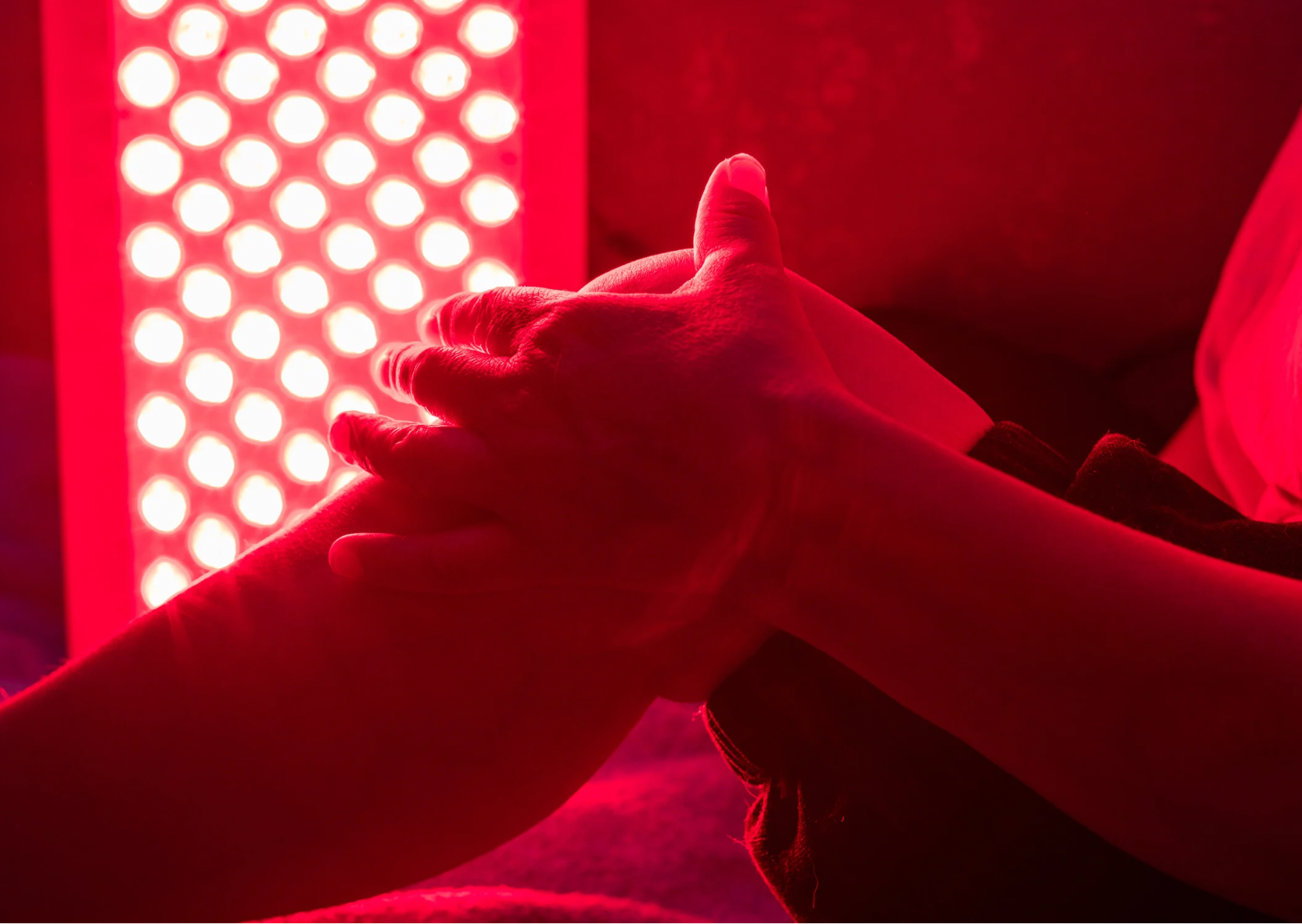Does any red light work for red light therapy? Including a bulb used for lighting?
These two are completely different:

There's a lot of misleading information about red light therapy, but the reality is that red light bulbs for lighting and LED-based health devices (like LUMEBOX) are very different.
In this post, we debunk some common myths about LEDs and explain why beam angle is a critical factor in red light therapy!
Bad News about LEDs?
If you’ve heard that LEDs are bad for you, there’s more to the story.
LEDs, or light-emitting diodes, are commonly found in everyday items like lighting, TV screens, and phone displays. They are used for their energy efficiency, long lifespan, and bright, clear light.
Some concerns have been raised about the potential impact of LEDs on eye health due to the high levels of blue light emitted by some LEDs. However, not all LEDs are created equal. Red LED lights, whether a bulb for lighting or designed for red light therapy, do not emit the same levels of blue light and are much safer. They should not cause eye strain and headaches like bright white LEDs used for lighting.
What is Red Light Therapy?
Red light therapy FOR HEALTH involves the application of specific wavelengths of red and near-infrared light through the skin.
Tiny powerhouses in our cells called mitochondria have receptors (called cytochrome c oxidase) that pick up red and near-infrared light. When stimulated, the mitochondria produce more energy in our cells in the form of ATP. Almost all cellular functions in the body utilize ATP; think of it as the fuel that allows cells to do their work.
Suppose your mitochondria aren’t working at 100%. In that case, the cells don't have enough fuel to function properly. In a brain cell, this could show up as brain fog, or poor memory. In a liver cell, this could manifest as poor metabolism or detoxification, affecting your overall health and well-being.
Can’t you just use red light bulbs to activate the mitochondria?
No!
You might see people on the internet advocating for $40 ambient red bulbs like these, believing they offer the same benefits as red light therapy devices like a LUMEBOX.

The light from these bulbs SCATTER (see below for more details) and therefore will NOT penetrate through the skin in significant amounts to reach the mitochondria.
These are only good as a soothing alternative to bright white lighting before bed to help you avoid blue light exposure.
(For more tips on avoiding blue light at night, especially from phone screens, check out our blog all about sleep!)
If you want the skin, muscle, and joint benefits published in the research associated with red light therapy you need an LED or laser-based device that considers the following 3 factors:
1. Wavelength
Potent LED light therapy bulbs emit light at specific very wavelengths. Studies suggest that red light therapy using light at ~660 nm (red light) and ~850 nm (near-infrared light, or NIR) may be particularly beneficial.
2. Irradiance
Higher irradiance means more light energy reaches the cells. It’s essentially the power of light over a given area. When a wavelength has more power behind it, we are more likely to feel and see results.
3. Scatter & Beam Angle
Scattering happens when light emitted from a source interacts with particles in the air, which bounces the light in all directions. This reduces the intensity of the light that’s reaching a given area.
The wider the scatter (like below) the wider the beam angle - these factors affect how well the light penetrates.
A wide beam angle disperses light over a large area - this is what you’d find in typical incandescent bulbs and LED bulbs for room lighting.
A narrow beam produces focussed light for a target area - ideal for red light therapy.
So to help light reach the mitochondria in our cells, degrees matter!
What’s your red light goal?
1. Red Light for Ambience
If your goal is to use red light for illumination, like nightlights, reading lights, or creating a relaxing ambiance, a wider beam angle is ideal.
2. Red Light That Reaches Your Cells and Helps Them Work Better
Unlike the lighting bulbs shown above, LUMEBOX is designed to shine light in a narrow beam, focusing light on a precise area.
The focused nature of the beam means a high concentration of intense light can be delivered to a target area and better penetrate tissue.
Why lighting bulbs won’t work:
Incandescent bulbs emit all the colors of the light spectrum by heating a filament inside. To make the light red, a red filter is simply placed on the outside. As a result, the exact wavelengths of light emitted are unknown.
LED bulbs for lighting contain just the wavelengths in the red spectrum, rather than using a tinted filter. This is better than an incandescent bulb, but the shape of the bulb means that the light’s beam angle is very wide, so light still scatters and the wavelengths have little penetrative power.
Red Light Therapy Device: The LEDs used in high-quality red light therapy devices provide concentrated wavelengths within the red and near-infrared range. LUMEBOX emits light at 660 nm and 850 nm - the two most studied wavelengths for their health benefits. These precise wavelengths, plus the narrow beam angle, mean that the scattering of light can be minimized and the direct beam can more effectively reach the target tissue.
Plus, LUMEBOX also has a high irradiance which helps light reach the cells - this is because the device is highly powered. Neither type of bulb has a high enough power to work any magic.
What about infrared-style bulbs?
If you see a bulb that looks like this (see below), it uses an incandescent design to emit all the wavelengths from red to infrared in the spectrum.
While they are effective at heating the body from within (notably for infrared sauna), their bulb shape makes them more suitable for ambiance and heat rather than for targeted mitochondrial stimulation.

How to choose the best red light therapy device
Not All LED Red Light Therapy is Created Equal.
As red light therapy gains popularity, many companies are jumping on the trend and producing cheap products that offer minimal benefits. That's why it's a good idea to choose a trusted company, even if it costs a bit more.
Keep these key specs in mind when assessing the effectiveness of a red light therapy device:
Wavelength:
Unless a company has specifically measured the light wavelengths from their device using specialized equipment, there's no easy way to know if the wavelength they provide is accurate.
LUMEBOX Wavelength:
- Red = 600 nm
- Near-infrared = 850 nm
- 3rd party tested for wavelength and safety (see below).
Irradiance:
As a consumer, it can be tough to verify irradiance—some companies may claim their devices emit more power than they actually do. This happens because they often use handheld light meters, which aren't very accurate and can be manipulated to show higher readings. Some companies don't even share their irradiance, which can be a bit suspicious. Don't hesitate to reach out and ask companies about their irradiance, especially if you're looking for a high-powered device to replace those red light bulbs.
LUMEBOX irradiance measured from 1cm away:
- Red light =125 mW/cm2
- Near-infrared light = 140 mW/cm2
- LUMEBOX irradiance has been 3rd party tested and verified in a lab (see below).
LUMEBOX Quality and Testing:
EMF: 3rd party lab tested to have low EMF (most companies use EMF meters to test, not accurate). LUMEBOX meets IEC62233 EMF standards.
Safety: LUMEBOX meets necessary safety standards for wavelength and irradiance: IEC 60601-1, 60601-1-11, 60601-1-2, IEC 60601-1-57, IEC 62471
High quality: Good Manufacturing Practices (GMP) under ISO 13485, and every batch is 3rd party inspected for quality by SGS.
FDA registered: Offers consumers reassurance because we adhere to a set of quality standards and protocols set by the FDA.
The Takeaway: "Bulbs” vs. LED red Light therapy
LED light therapy devices like LUMEBOX are specifically designed to emit precise wavelengths of red and near-infrared light, which are designed to penetrate tissue and reach the mitochondria.
In contrast, red light bulbs for lighting, even if they use LED technology, typically have a wider beam angle and aren’t made with tissue penetration and mitochondrial health in mind.
When choosing your light source, consider your ultimate purpose: whether it's to illuminate your space or to prioritize your health through red light therapy.
New to red light therapy? Download our free eBook to help you choose the best device.
Already have a LUMEBOX? Download our 6 time-saving tricks guide!
Medical Disclaimer: The information contained in this blog post is intended for educational purposes only and should not be used as medical advice. Everyone responds to light differently. Testimonials are not a guarantee of the results you or anyone who uses LUMEBOX will get because your success depends entirely on your circumstances, and the studies on red light therapy shared were not specifically performed using LUMEBOX. Please check with your doctor before using red light therapy and do not change your medical treatments or lifestyle without consulting your physician first.












